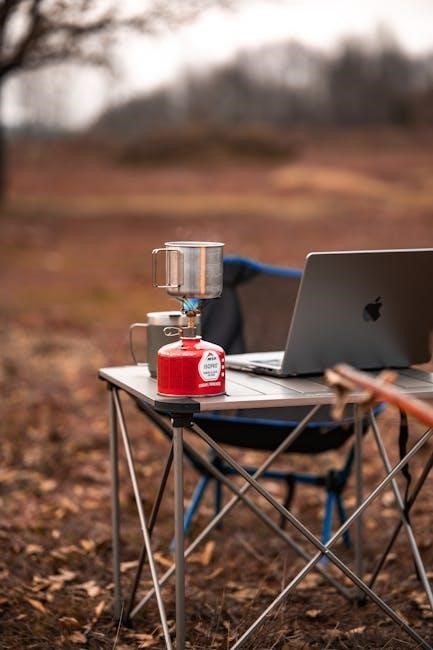Embark on a thrilling adventure in Texas, exploring the wild habitats of Rio Grande turkeys. Self-guided hunts offer autonomy, allowing you to immerse yourself in nature at your own pace.
Overview of the Rio Grande Turkey
The Rio Grande Turkey (Meleagris gallopavo intermedia) is a resilient and iconic subspecies native to the southern Great Plains. Known for its striking plumage and vibrant calls, it thrives in Texas’s diverse landscapes, including woodlands, grasslands, and scrub habitats. These birds are highly adaptable, making them a popular target for hunters. Rio Grande Turkeys are social creatures, often roaming in flocks, and are recognized for their intelligence and wary nature. Their distinctive gobbles and clucks are key communication tools, playing a vital role in hunting strategies. As a game bird, they are deeply rooted in Texas outdoor traditions, attracting hunters seeking both challenge and connection with nature.
Why Choose Texas for Your Self-Guided Turkey Hunt?
Texas offers unparalleled opportunities for self-guided Rio Grande turkey hunts due to its vast, diverse landscapes and abundant wildlife. The state’s expansive public and private lands provide ideal habitats for these birds, ensuring a thriving population. With liberal bag limits and a long hunting season, Texas caters to both experienced hunters and newcomers. The scenic beauty of the Lone Star State, from rolling hills to dense woodlands, enhances the hunting experience. Additionally, Texas’s well-managed wildlife areas and accessible resources make it an ideal destination for those seeking an independent, immersive outdoor adventure. The combination of challenging terrain and plentiful game ensures a memorable hunt.

Best Locations for Rio Grande Turkey Hunting in Texas

Texas offers prime locations for Rio Grande turkey hunting, with hotspots in the Hill Country, South Texas, and East Texas, known for abundant wildlife and ideal terrain.
Top Public Hunting Lands in Texas
Texas boasts an extensive network of public hunting lands, offering ideal habitats for Rio Grande turkey hunting. The Texas Parks and Wildlife Department manages numerous Wildlife Management Areas (WMAs) and public leases, providing access to prime turkey habitats. Key locations include the Hill Country, where rolling hills and wooded landscapes create perfect conditions for turkey populations. South Texas, with its dense brush and grasslands, is another hotspot, particularly around areas like the Chaparral WMA. Additionally, East Texas’s forests and bottomlands offer ample opportunities. These public lands are well-managed, ensuring sustainable hunting practices while providing hunters with diverse and rewarding experiences. Proper permits and regulations apply.
Private Ranches and Lease Options
For a more exclusive experience, private ranches and lease options in Texas offer unparalleled access to prime Rio Grande turkey habitats. Many ranches across the state, particularly in the Hill Country, South Texas, and East Texas, cater to self-guided hunters. These properties often boast well-managed ecosystems, ensuring robust turkey populations. Leasing options provide hunters with private access, reducing competition and increasing success rates. Ranches may also offer amenities like lodging and guided scouting, though hunters can still pursue their adventure independently. Private lands often feature diverse terrain, from open fields to dense woodlands, creating ideal conditions for turkey hunting. This approach allows hunters to tailor their experience to their preferences and skill levels.
Understanding Rio Grande Turkey Behavior
Rio Grande turkeys are social birds, often found in small groups, with males (toms) displaying vibrant plumage during mating season. They are most active at dawn and dusk.

Habitat Preferences and Movement Patterns
Rio Grande turkeys thrive in mixed woodlands and open grasslands, preferring areas with scattered trees like live oak and mesquite. They often roost in tall trees at night, moving to feeding grounds at dawn. Their movement patterns are influenced by seasonal changes, with turkeys shifting between higher elevations in summer and lower areas in winter. Water sources are critical, drawing turkeys to creeks, ponds, and agricultural fields. For self-guided hunters, understanding these habitat preferences and movement patterns is key to locating birds effectively. Scouting edges where woodlands meet open fields and monitoring water sources can significantly improve hunting success in Texas.
Calling Techniques for Rio Grande Turkeys

Mastering calling techniques is essential for successful Rio Grande turkey hunting. Gobbler, hen, and jake calls are commonly used to mimic natural turkey communication. Start with soft, realistic clucks and purrs to attract birds without startling them. Loud, aggressive gobbler calls can provoke dominant males, while subtle hen calls work well for drawing in cautious birds. Timing is crucial—call frequently during peak activity at dawn and mid-morning. Avoid overcalling, as this can spook wary turkeys. Use box calls, mouth calls, or slate calls, depending on your preference. Practice realistic sequences to mimic natural turkey behavior, increasing your chances of luring birds into range. Patience and precision are key to effective calling in the field.

Planning Your Self-Guided Hunt
Research locations, understand turkey behavior, and prepare gear. Ensure licenses are secured and strategies are tailored to Texas’s unique hunting conditions for a successful experience.
Best Times of the Year for Turkey Hunting in Texas
The Rio Grande turkey hunting season in Texas typically runs from late March to early May, with the peak gobbling activity occurring in April. Hunters should plan their trips during this window for optimal success.
Fall hunting is also permitted, though it is shorter, usually in October or November. Spring remains the most popular season due to the males’ vocal activity, making it easier to locate birds.
Timing your hunt during the right phase of the breeding season increases chances of encountering active birds. Always check Texas Parks and Wildlife Department for exact season dates and regulations before planning your hunt.
Obtaining Necessary Licenses and Permits
Before heading out on your self-guided Rio Grande turkey hunt in Texas, ensure you have the proper licenses and permits. The Texas Parks and Wildlife Department requires a valid hunting license, which can be purchased online or at local retailers.
Residents and non-residents must obtain a Turkey Hunting License, and additional permits may be needed for specific properties or hunting lease agreements. Be sure to review the regulations and obtain any required stamps or tags.
Always verify the most up-to-date licensing requirements on the Texas Parks and Wildlife Department’s official website to ensure compliance and avoid penalties during your hunt.

Essential Gear for a Successful Hunt
A shotgun, camouflage clothing, and essential optics like binoculars are must-haves. Include turkey calls and decoys to enhance your hunting strategy and increase success rates dramatically.

Weapons and Optics
For a successful hunt, a reliable shotgun is essential, with 12-gauge being the most popular choice. Opt for a turkey-specific choke to ensure tight shot patterns at longer ranges.

Clothing and Camouflage
When preparing for a self-guided Rio Grande turkey hunt in Texas, proper clothing and camouflage are crucial for success. Opt for full camouflage suits, including head and face coverage, to blend seamlessly into the terrain.
Choosing patterns like Mossy Oak or Realtree, designed for woodland and open field environments, will help you remain concealed. Layering clothing is essential to adapt to varying weather conditions, with breathable fabrics for warmer days and insulated layers for cooler mornings.
Sturdy, quiet footwear with good traction is a must for navigating Texas’s diverse landscapes. Additionally, gloves and a facemask can enhance concealment and protect against the elements. Dressing appropriately ensures a more effective and enjoyable hunting experience.
Hunting Strategies and Techniques
Mastering scouting, decoy placement, and effective calling is essential for a successful self-guided Rio Grande turkey hunt in Texas; Hunt during peak gobbling times for optimal results.
Scouting and Setting Up
Scouting is crucial for identifying Rio Grande turkey habitats and movement patterns. Look for signs like droppings, feathers, and scratch marks in wooded areas or open fields. Use binoculars to spot birds from a distance and track their daily routines. Set up blinds or decoys near feeding or roosting sites, ensuring a clear shooting lane. Position yourself downwind to avoid detection, as turkeys have a keen sense of smell. Early morning setups are ideal, as turkeys are most active during this time. Utilize topographic maps to locate edge habitats where turkeys often forage. Proper setup increases your chances of a successful harvest.
Effective Calling and Decoy Strategies
Mastering calling and decoy techniques is essential for attracting Rio Grande turkeys. Start with soft clucks and yelps to mimic a hen, gradually increasing intensity to draw gobblers. Use a variety of calls, such as tree yelps and fly-down cackles, to simulate real turkey behavior. Decoys should include hens, jakes, and strutters to create a realistic setup. Place decoys in open areas, ensuring visibility from multiple directions. Avoid overcalling, as turkeys can become wary. Instead, mimic natural sequences, allowing silence between calls to build curiosity. Position yourself to blend with the surroundings, using decoys to funnel turkeys into your shooting range. Timing and patience are key to success.
Safety and Ethics in Self-Guided Hunts
Always wear blaze orange for visibility and ensure ethical hunting practices. Respect the environment, follow local regulations, and prioritize clean, humane kills to maintain sustainable hunting traditions.
Responsible Hunting Practices
Adhering to ethical guidelines is crucial for sustainable hunting. Always follow local regulations, respect private property, and minimize environmental impact. Hunters should practice fair chase, ensuring humane and clean kills. Harvesting only what is needed and properly utilizing the animal reduces waste. Avoiding overhunting preserves turkey populations for future generations. Respecting fellow hunters and the land fosters a positive hunting community. Ethical practices not only uphold conservation efforts but also promote a respectful relationship with nature and wildlife, ensuring the tradition of self-guided Rio Grande turkey hunting remains viable and enjoyable for years to come.
Emergency Preparedness
When venturing into the wilderness for a self-guided Rio Grande turkey hunt, preparedness is key. Always carry a first aid kit, a reliable means of communication, and a GPS device or map. Pack extra water, non-perishable snacks, and weather-appropriate clothing to handle unforeseen situations. Familiarize yourself with basic survival skills and know how to start a fire or navigate using landmarks. Inform someone of your itinerary, including where you’ll hunt and when you plan to return. Be aware of potential hazards like inclement weather or wildlife encounters. Stay vigilant and know emergency contact numbers. Proper preparation ensures a safe and enjoyable hunting experience in Texas’s vast outdoor spaces.

Post-Hunt Procedures
- After harvesting, field dress the turkey immediately to preserve meat quality.
- Properly store and transport the bird to prevent spoilage.
- Document your hunt with photos and log your harvest for future reference.
Field Dressing and Processing
Field dressing is crucial for preserving the quality of your harvested turkey. Begin by making precise cuts to remove the innards, taking care to avoid damaging the meat. Use a sharp knife for clean incisions, and work methodically to ensure all organs are removed. Once dressed, cool the bird as soon as possible to prevent spoilage. For processing, consider skinning or plucking, depending on your preference. Properly store the meat in airtight containers or vacuum-seal it for freezing. Always follow safe food handling practices to maintain freshness and prevent contamination. Proper field dressing and processing ensure a safe and enjoyable harvest for consumption.
Preserving Your Harvest
Properly preserving your Rio Grande turkey ensures a delicious and safe meal year-round. Start by wrapping the meat tightly in plastic wrap or aluminum foil, then place it in airtight containers or vacuum-sealed bags to prevent freezer burn. For long-term storage, freezing at 0°F or below is ideal. Consider canning or smoking for a unique flavor and extended shelf life without refrigeration. Dehydrating, such as making jerky, is another excellent option for convenient snacks. Always follow food safety guidelines to maintain quality and prevent spoilage. Preserving your harvest allows you to enjoy the fruits of your hunt long after the season ends.
Self-guided Rio Grande turkey hunts in Texas offer a rewarding, hands-on experience. With proper planning and preparation, hunters can enjoy a memorable adventure in the Lone Star State.
Final Tips for a Memorable Experience
For a memorable self-guided Rio Grande turkey hunt in Texas, ensure thorough planning and preparation. Scout locations beforehand to identify prime habitats and movement patterns. Always check equipment and optics for functionality. Respect the environment and wildlife, adhering to ethical hunting practices. Stay patient and attentive, as turkeys can be unpredictable. Capture memories with photos and journals to cherish the experience. Lastly, embrace the solitude and beauty of nature, making the hunt a fulfilling adventure. With dedication and knowledge, your self-guided hunt will be a success and a lasting memory.

